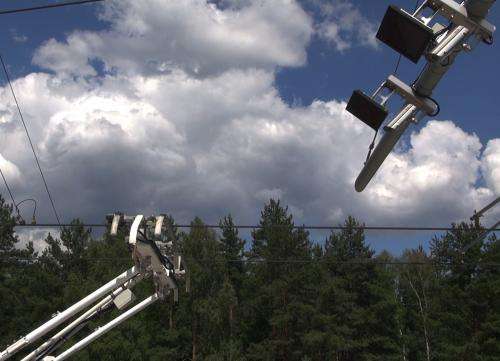Siemens is developing an automatic monitoring system for pantographs. Designed initially for electric and hybrid trucks on eHighways, the system uses cameras and sensors to check the condition of pantographs in order to prevent damage to the overhead contact wire. Similar but much more complex systems are occasionally used for electric trains.
Siemens is developing an automatic monitoring system for pantographs. Designed initially for electric and hybrid trucks on eHighways, the system uses cameras and sensors to check the condition of pantographs in order to prevent damage to the contact wire. Similar but more complex systems are occasionally used for electric trains.
The eHighway system is a low-emission solution that was developed by Siemens for heavily used truck shuttle routes. Electric or hybrid-drive trucks use pantographs to draw electric power from overhead conductors, which allows them to travel with practically no emissions. On an eHighway, which will be used by vehicles with many different owners, monitoring the pantographs is especially important to prevent route closures that may become necessary because of damaged overhead conductors. The eHighway solution is a compact and inexpensive system that can be installed at various points along the route and simultaneously detects whether the vehicles are authorized. Siemens introduced the solution recently at the Innotrans 2014 trade fair and demonstrated how it can be applied to electric trains.
Whether on a truck or train, the pantographs are subject to wear and tear during operation. The carbon contact strips, in particular, wear out through contact with the overhead wire. If worn-out or recently damaged contact strips are not detected in time, grooves, fractures, or uneven wear could lead to contact problems and thus to damage of the contact wire of the overhead conductor. In extreme cases, the overhead contact wire might even break.
Special cameras monitor the contacts
The system monitors the pantograph in two ways. Cameras monitor the carbon surfaces on the contact strip. Special algorithms evaluate the level of wear or incipient damage. As soon as enough measurement data is available from various systems, the solution will also try to predict when the carbon strips have to be replaced. Maintenance is thus possible according to the state of wear, and the contact strips will be used for as long as possible. In addition, sensors register the vertical deflection of the overhead contact wire. From this, the pressure on the wire can be inferred. If the pantograph presses on the wire with too much force, there is excessive wear on the carbon layer as well as the overhead contact wire. If the pressure is too low, the contact could be broken, and arcing might occur, which also stresses both sides of the connection.
The system is designed in such a way that it can be installed at the poles of the overhead conductor as well as on bridges in order to take measurements at as many points as possible along the route. This makes it possible to draw additional inferences regarding the condition of the infrastructure - the suspension of the overhead contact wire, for instance. In the case of electric trains, the train stations or depot entrances are appropriate spots for measurements. The condition of the pantograph is transmitted to the control centers, the maintenance engineers or to an onboard unit in the truck. Siemens is operating the monitoring system at its test facility for eHighways and is currently optimizing the automatic analysis, including the process for evaluating the contact strips, for instance. After that, a functional prototype is planned.
Provided by Siemens






















